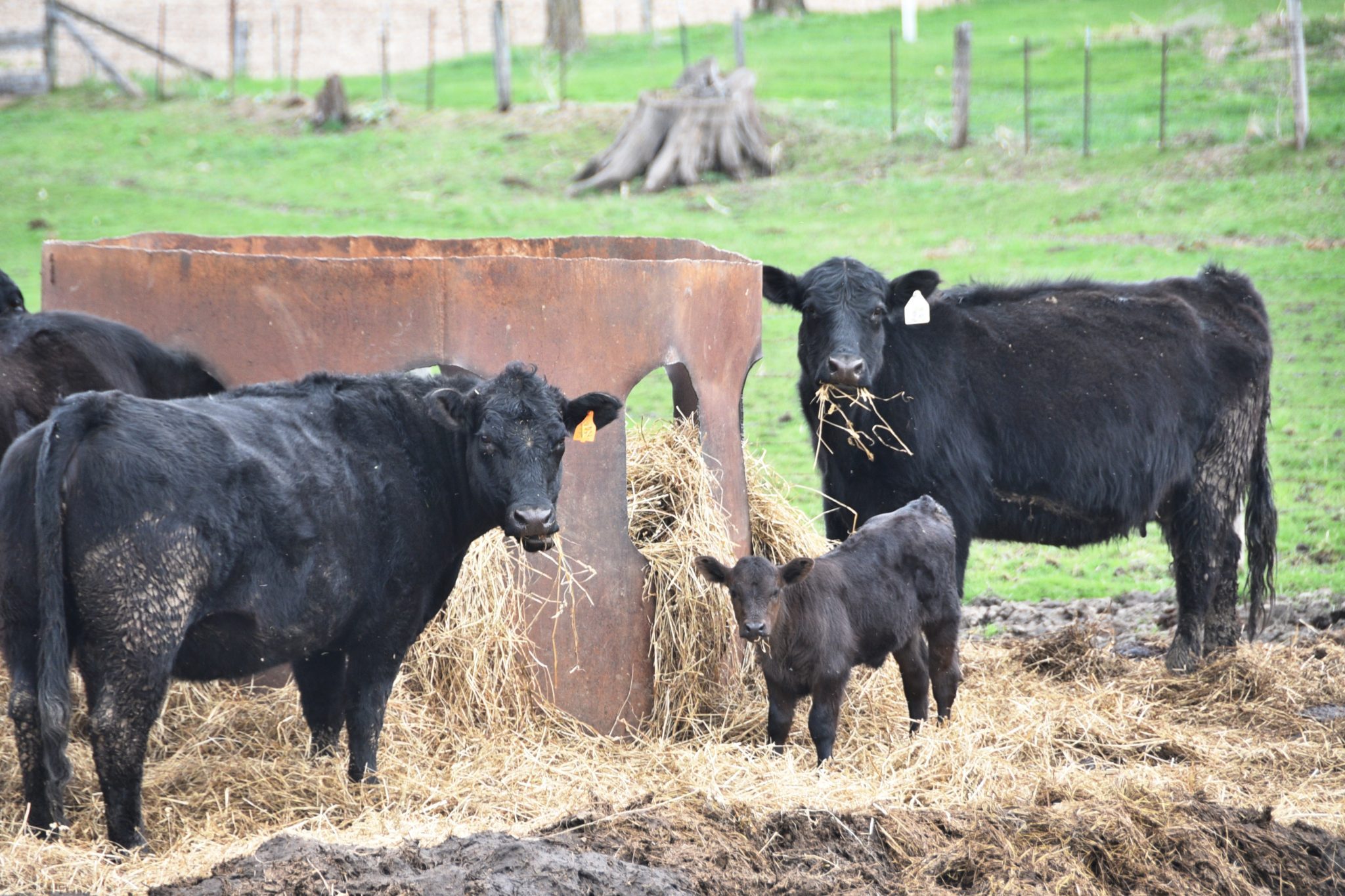Beef

Farmers face numerous challenges when their pastureland is affected by floods.
General Tips
- Inventory livestock. Immediately after a flood event, inventory all livestock and identify missing animals.
- Check the area. When livestock have been moved to a new area to escape flood waters, check the area to make sure there are no hazardous objects in the area. These might include old equipment that could scrape or gouge livestock, chemical containers, bale wrap or hay twine.
- Observe livestock for sickness. Check livestock for wounds and seek attention from a veterinarian immediately. Continue to monitor herd health in the days following a flood event.
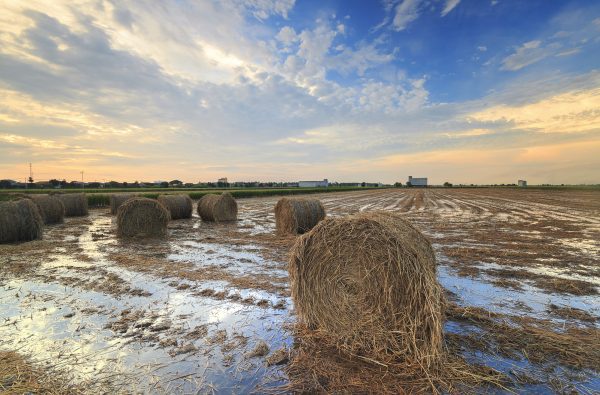 Damage to Hay
Damage to Hay
- Document all losses of hay as soon as it is safe to do so.
- Take photos of bales or the place where bales were stored prior to the storm.
- Write down the number of bales, type and quality of hay, and the estimated weight or size (i.e., 4 × 4, 4 × 5, etc.).
- Contact the Farm Service Agency (FSA) office, and visit them with this information as soon as possible.
- Eligible hay losses may be covered under the Emergency Assistance for Livestock, Honeybees, and Farm- raised Fish Program (ELAP). Find more information at www.fsa.usda.gov.
- To qualify for the program, hay had to have been baled. The program will not cover hay that was cut and on the ground.
- This program covers only hay purchased to feed or hay cut to feed. The program does not cover hay that was cut to sell.
- Document flooded hay versus hay that was rained on.
- When possible, have an Extension agent or other official help you document your losses.
- File a notice of loss at the FSA office within 30 days of the loss.
Feeding Damaged Hay
- Even if hay was not submerged in water, heavy rains will likely decrease the quality of hay stored outside or on the ground.
- Hay that is submerged by as little as 1 foot has limited usable forage remaining.
- The amount of rotted hay, mold, and possible contaminants in flooded hay make it of little value and potentially a hazard to livestock.
- Hay that has less than 1 foot submersion may still have some usable forage, but it should be used with caution and should be fed only to cattle.
- For hay submerged less than 1 foot of water, feed the dry hay but do not force the cattle to consume the wet and rotting portion of the bale.
- Hay that was flooded in storage barns should be removed as soon as possible to prevent hay fires. This hay will begin to heat and spontaneous combustion is a possibility.
- Hay that is not fit for livestock should be disposed of by burning or composting it.
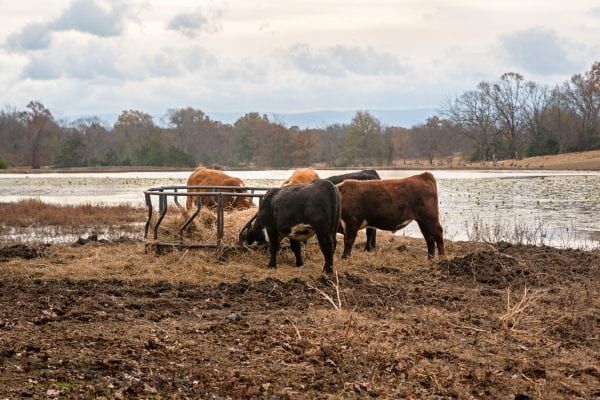 Salvaging/Loss of Feedstuffs
Salvaging/Loss of Feedstuffs
- Feed that farmers had on hand (including commercial feed and harvested commodities) may be covered by the ELAP program. Farmers need to document the amount and type of feed that was damaged and the type of damage that occurred.
- Salvaging flooded feed may be possible, but it must be done quickly after a flood event. If feed is stored in bins, remove any dry feed from the top and move to a different area for later use.
- If possible, remove wet grain from storage containers and spread out to dry in a layer no more than 6 inches deep.
- Test flooded grains for mycotoxin load. Additional information on mycotoxin testing services can be found at the end of this document.
- Pelleted feeds may be more difficult to salvage and will begin to degrade once wetted. It is possible to still utilize these feeds in the short-term, but monitor them closely for mold growth or rancidity.
Pastures
- Flooded pastures will likely be severely affected.
- Winter annuals that were seeded before the flood and are relatively short are unlikely to survive flooding. Larger plants may survive a short period of flooding, but extended submersion will likely kill the forage.
- Established tall fescue fields can survive 7 to 10 days of flooding. Allow for a recovery period of 1 to 2 weeks before allowing livestock access to these fields.
- The ELAP program will also cover losses to pastures, but flooding will need to be documented.
- Use an aerial map to log the time line of the flood and when waters recede as well as the number of days of grazing lost. Your Extension agent or other adviser can help you determine how many grazing days were lost. Grazing days are reimbursed at a rate of $0.94 per day, regardless of livestock species.
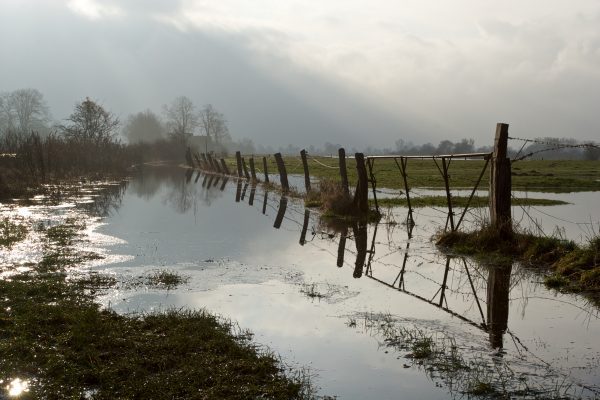 Physical Damage to Fences and Grazing Lands
Physical Damage to Fences and Grazing Lands
- Removal of debris, repair of land, and repair of fences may be covered by the Emergency Conservation Program (ECP).
- This program is designed specifically for dealing with cleanup following a storm and repairing damage.
- A field inspection by FSA is recommended to determine eligibility for the program.
- It is critical that producers experiencing a loss take good pictures and document the number of feet/miles of fence that were lost.
Livestock Death from a Storm Event
- An unfortunate consequence of owning and raising livestock is the inevitable death of some animals, despite even the best animal husbandry and veterinary care. Animals may die as a direct result of or following a storm. Causes may be injuries, illness, lack of adequate food and/or water, etc.
- Livestock owners and custodians must, therefore, understand methods of responsible carcass disposal to protect their herds from various infectious diseases, be good stewards of the environment, and promote a positive image for the livestock industry.
- Proper carcass disposal first and foremost ensures the safety of the herd by removing the source of a variety of infectious diseases as well as protecting wildlife from the same diseases. Proper carcass disposal also helps to avoid environmental problems and the undesirable publicity the livestock industry receives when carcasses are found in inappropriate places, such as creeks, ponds, and along the side of a road.
- Alabama law requires carcass disposal within 24 hours. Approved methods of carcass disposal include burial and burning as well as disposal in an approved landfill (contact your local landfill for more information). Burial is not an option for locations in Alabama with a high water table. If an incinerator is used to burn mortalities, use one approved by the Alabama Department of Environmental Management Air Division.
- Four Alabama Department of Agriculture Veterinary Diagnostic Laboratories are also available to perform an examination into the cause of death (necropsy) and then dispose of the carcass. Contact information for the four Alabama Veterinary Diagnostic Laboratories is listed below. These labs should be used only when the cause of death needs to be determined.
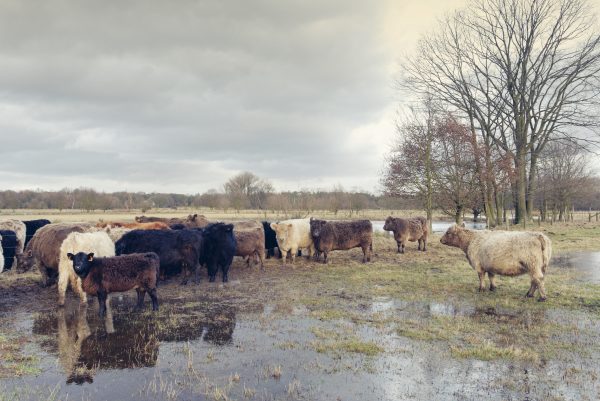 Maintaining Health of Grazing Livestock
Maintaining Health of Grazing Livestock
- Death loss as a result of a storm needs to be documented with photos and reported to the FSA as part of an application to the Livestock Indemnity Program (LIP). This includes death losses directly related to the storm (e.g., a barn collapsing) or indirectly related (e.g., inadequate feed or water for days or weeks after a storm).
- Feeding levels for animals that have been short on feed for several days or a week need to be higher than normal maintenance rations usually fed this time of year. Animals that have lost significant body condition due to feed restriction will need to gain weight significantly and are likely to need supplemental concentrate in addition to good-quality hay or pasture. Make sure that a good-quality mineral supplement is being provided and that the cattle are eating it.
- Livestock will be vulnerable to a number of diseases following a flooding event. These include respiratory disease, clostridial diseases such as black leg, leptospirosis, and infections due to cuts and loss of integrity of skin and hooves as a result of prolonged exposure to standing water or wet conditions. These diseases may result from either increased environmental exposure to the pathogens in question or due to comingling with other livestock that carry the diseases. Livestock on a good health program will have been vaccinated for most of these diseases, improving the outcome when they undergo stress and pathogen exposure.
- Storm-affected animals that have not been on a good health program (including vaccination for clostridial diseases, leptospirosis, and respiratory diseases) should be vaccinated once they have been contained and have received adequate feed for several days.
- Developing a relationship with a local veterinarian is an incredibly important part of a livestock management program. If a producer does not enjoy that kind of relationship, he or she is encouraged to identify a veterinarian and develop a proactive health program.
- Remember, maintaining an adequate nutritional plane of impacted animals is a key to development of a high level of immunity to disease when vaccines are administered.
Guide for Forage, Feed, and Diagnostic Services
Soil, Forage & Feed Testing
Services: Soil fertility recommendations, basic forage and feed quality analysis (TDN, CP, etc.), nitrates and minerals upon request
(334) 844-3858
Go to Forms and Publications for submitting samples
Alabama State Veterinary Diagnostic Services
Thompson Bishop Sparks State Diagnostic Laboratory, Auburn, AL
(334) 844-4987
Contact for additional information on necropsy and animal/feed toxicology analyses.
Mitchem-Sparks Regional Poultry Diagnostic Laboratory, Boaz, AL
(256) 593-2995
Hinton Mitchem Regional Poultry Diagnostic Laboratory, Hanceville, AL
(256) 352-8036
J. B. Taylor Regional Poultry Diagnostic Laboratory, Elba, AL
(334) 897-6340
Alabama Department of Agriculture & Industries
General
Alabama Cooperative Extension System
Web resources: www.aces.edu
Extension agent directory: www.aces.edu/directory
Facebook: www.facebook.com/alabamabeefsystemsextension
Leanne Dillard, Extension Specialist, Assistant Professor, Kim Mullenix, Extension Specialist, Associate Professor, and Soren Rodning, Extension Specialist, Professor, all in Animals Sciences and Forages, Auburn University
Revised March 2022, Animal, Forage & Feed Management After a Flood, ANR-2536
For assistance with any of the mentioned programs, please contact your local Animal Science and Forage Extension agent. This information can be found at aces.edu or by contacting your county Extension office.
This article was adapted, in part, with permission from a previous article by Matt Poore, North Carolina State University.

